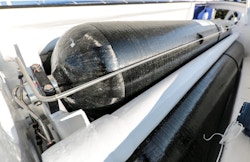Already 8000 nautical miles of navigation with our demonstrator
Energy Observer is a real educational boat, a demonstration vessel. “With its choice of battery and fuel cell energy mix, the boat forecasts the future of maritime travel” states Victorien Erussard, Captain at the start of the project. “I am convinced. We worked on a demonstration model, an intelligent vessel that would forecast tomorrow’s energy networks. We wanted to represent the virtuous circle by using several forms of renewable energies and storage.”

An obvious choice. If the experimental catamaran’s energy were stocked only in Lithium batteries, the added storage weight would represent an added 14 tons. The hydrogen solution allows 50 % weight gain. The range extender automatically passes through the fuel cell granting the possibility of storing hydrogen.

Hydrogen tanks
Energy Observer’s current configuration, with solar panels and a hydrogen-powered fuel cell, suits the Mediterranean. “I’m concerned about next year, when we’ll be in northern Europe, where the rate of sunshine is reduced“, states Victorien. “We are going to work this winter on integrating new technologies and increasing the vessel’s performance.”
A permanent change
Energy is truly at the heart of the catamaran’s daily life. At sea, life on board revolves around its production and consumption. “We realized that consumption becomes significant as soon as we increase speed” says Victorien Erussard. It’s exponential. Every extra knot (editor’s note: 1,852 km/h) costs energy.
The optimal cruising speed of the all-electric catamaran is purposely set at 4.7 knots (editor’s note: 8.7 km/h) by Roland Reynaud, one of the engineers on board. These speeds may seem trivial for land dwellers, but they allow Energy Observer to realize distances of up to 1,000 km in 4 days. “In the end, we travel miles and miles. A cruising sailboat, which navigates with a sail and motor, manages an average of 5 knots. ”
A technology under control

Energy Observer's bifacial solar panels
The only limitation is the need to make regular, technical stopovers, long enough to charge the batteries on land and also to replenish the hydrogen reserves used at night to make up for solar energy.
At the time of this initial assessment, the revolutionary system is fully operational. The two engineers on board, trained at the Alternative Energies and Atomic Energy Commission (CEA), who up until recently have both remained on board, will alternate with the crew groups.
“Everything is becoming automatic. Software intelligence is a real success for the vessel. The entire electronic managing system is automated. As soon as a lack of energy becomes apparent, the fuel cell starts up automatically. In the same way, it shuts down when the sun takes over.”

#EnergyObserver travelled almost 8000 nautical miles. Half-way through the #Mediterranean tour, our captain Victorien Erussard is satisfied of the combination of #solarpanels and the #hydrogen fuel cell that powers the boat. In the Mediterranean, this energy mix can ensure the crew very safe and self-sufficient navigations.
Future innovations
The project’s research and development component has been approved. The next step is its educational component. “Using this demonstration model, we play the role of ambassadors to hydrogen.”
The development of this carbon-free vessel is permanent. But the technological adventure continues, with new developments on the horizon. Energy Observer will continue its Odyssey around the world until 2022, with the continued support of private partners and the Ministry for the Ecological and Inclusive Transition (METS), in order to discover these technologies of the future and meet the stakeholders of sustainable development globally.